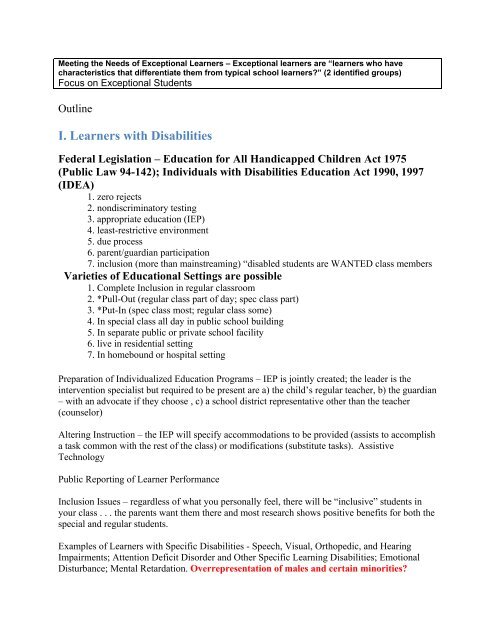Section 7 - Focus on Exceptional Children
Section 7 - Focus on Exceptional Children
Section 7 - Focus on Exceptional Children
You also want an ePaper? Increase the reach of your titles
YUMPU automatically turns print PDFs into web optimized ePapers that Google loves.
Meeting the Needs of Excepti<strong>on</strong>al Learners – Excepti<strong>on</strong>al learners are “learners who havecharacteristics that differentiate them from typical school learners?” (2 identified groups)<str<strong>on</strong>g>Focus</str<strong>on</strong>g> <strong>on</strong> Excepti<strong>on</strong>al StudentsOutlineI. Learners with DisabilitiesFederal Legislati<strong>on</strong> – Educati<strong>on</strong> for All Handicapped <strong>Children</strong> Act 1975(Public Law 94-142); Individuals with Disabilities Educati<strong>on</strong> Act 1990, 1997(IDEA)1. zero rejects2. n<strong>on</strong>discriminatory testing3. appropriate educati<strong>on</strong> (IEP)4. least-restrictive envir<strong>on</strong>ment5. due process6. parent/guardian participati<strong>on</strong>7. inclusi<strong>on</strong> (more than mainstreaming) “disabled students are WANTED class membersVarieties of Educati<strong>on</strong>al Settings are possible1. Complete Inclusi<strong>on</strong> in regular classroom2. *Pull-Out (regular class part of day; spec class part)3. *Put-In (spec class most; regular class some)4. In special class all day in public school building5. In separate public or private school facility6. live in residential setting7. In homebound or hospital settingPreparati<strong>on</strong> of Individualized Educati<strong>on</strong> Programs – IEP is jointly created; the leader is theinterventi<strong>on</strong> specialist but required to be present are a) the child’s regular teacher, b) the guardian– with an advocate if they choose , c) a school district representative other than the teacher(counselor)Altering Instructi<strong>on</strong> – the IEP will specify accommodati<strong>on</strong>s to be provided (assists to accomplisha task comm<strong>on</strong> with the rest of the class) or modificati<strong>on</strong>s (substitute tasks). AssistiveTechnologyPublic Reporting of Learner PerformanceInclusi<strong>on</strong> Issues – regardless of what you pers<strong>on</strong>ally feel, there will be “inclusive” students inyour class . . . the parents want them there and most research shows positive benefits for both thespecial and regular students.Examples of Learners with Specific Disabilities - Speech, Visual, Orthopedic, and HearingImpairments; Attenti<strong>on</strong> Deficit Disorder and Other Specific Learning Disabilities; Emoti<strong>on</strong>alDisturbance; Mental Retardati<strong>on</strong>. Overrepresentati<strong>on</strong> of males and certain minorities?
II. Gifted LearnersThe Selecti<strong>on</strong> Issue1. use more than just academic ability . . . psychomotor ability, creativity;2. is there gender bias?Pressures Facing Gifted Learners – to whom much is given; much is expected . .. the curse of being gifted and talented.1. parents have high expectati<strong>on</strong>s2. teachers expect them to be a star in everything3. may therefore set unreas<strong>on</strong>able standards for themselves4. may be made fun of by peers5. may have low opini<strong>on</strong> of less able peers6. may challenge and enrage some teachers, become bored even and stopstudying . . . realize they can get by without trying hard7. fragile self imageMoving and Special Programs for the Gifted1. Enrichment Programs (pull outs)2. Accelerati<strong>on</strong> Programs – (subjects or grade levels) moving gifted studentsthrough the same curriculum but moving them faster (Piaget called this theAmerican questi<strong>on</strong> . . . “can we get our children to learn faster”) accelerati<strong>on</strong>is not <strong>on</strong>e of my favorite approachesDeveloping Gifted Learners' Potential within your own class1. challenge the gifted students to engage in resp<strong>on</strong>sible risk taking2. send positive signals when student resp<strong>on</strong>ds creatively and unexpectedly3. create assignment extensi<strong>on</strong>s that will involve and challenge giftedstudents . . . but not anger them in doing “extra” work . . .4. think about ways that gifted students can be used as an asset in class sothat peers will value them.
















